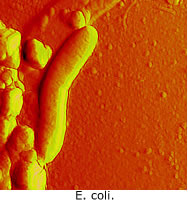Copper can prevent E. coli infection, say UK scientists
As the European Union prepares for the creation of a new European food authority, scientists in the UK have made a breakthrough discovery which could help fight a major food-related illness. A team at the University of Southampton, led by Professor Bill Keevil has found that copper surfaces for food preparation could significantly reduce the risk of food poisoning from bacteria such as E. coli (Escherichia coli) 0157. The bacteria causes haemorrhaging and consequently loss of blood. One of the worst outbreaks was in Scotland in 1997, when 20 people died and 500 fell ill as a result of E. coli 0157. The team has made the discovery after two years of studying the effect of copper surfaces on E. coli 0157 cultures. The research is being funded by the International Copper Association (ICA), which funds studies into the use of copper worldwide, including in Europe. Professor Keevil and his team carried out the study by dropping E. coli 0157 cultures onto a surface, letting them dry and then incubating them at either 4 degrees Celsius or 20 degrees Celsius. As expected, E. coli 0157 proved to be very robust, surviving on stainless steel surfaces for between two and three months. 'We were surprised at how long 0157 survived, particularly in a dried state on surfaces,' Professor Keevil told CORDIS News. He added that chilled food companies were very concerned by these results. Cultures dropped onto a copper surface however died as quickly as three to four hours later, which was less of a surprise to Professor Keevil as he was already aware that copper was inhibitory. These results will obviously be very interesting for all those involved in food preparation, including hospitals, restaurants, factories and shops. 'Stainless steel is used throughout the world because of its perceived hygienic properties. It always looks like a nice, clean and bright surface,' said Professor Keevil. 'But a closer look reveals scratches and marks which, on a microscopic scale, are more like valleys. It is very easy for pathogens to get into these crevices and rubbing a cloth or brush across the surface may not be sufficient to get them out,' he continued. Copper alone is not however appropriate for all food preparation, as acidic foods such as citrus fruits have a corrosive effect on this metal. This will be addressed in the next stage of the study, about to commence, which will focus on finding a copper alloy which retains its bacterial killing properties but can also be used hygienically as a food preparation surface. Brass for example also has a killing effect, although not as effective as copper, Professor Keevil told CORDIS News. The next stage of work will also investigate newly emerging strains of E. coli, particularly 0111, which is the predominant strain in Australia, and possibly 026, which appears to be the predominant strain in Italy and surrounding countries. This study follows previous projects by the Southampton team which also looked into the possibilities of using copper to the benefit of human health. Around three years ago the focus was on water contamination, where it was shown that the use of copper significantly reduced the risk of infection from E. coli 0157. This study worked on the results of earlier research, conducted 12 years ago, into legionnaires disease when it was discovered that using copper pipes instead of plastic or metal suppressed the development of legionella. Copper was already being used by ancient Egyptians to keep water fresh. Asked why it has taken so long for scientists to investigate the possibility of using copper on food preparation surfaces, Professor Keevil cited fashion as the reason. 'Modern society has seen the development of new materials [...] which didn't corrode and modern plastics, which are easy to shape. There has been a move away from copper,' he said.



